BY MICHAEL J. BARAKEY AND DEBORAH L. GAUDET
On April 6, 2012, the Virginia Beach (VA) Fire Department (VBFD) was faced with a significant incident that tested the department and city government’s ability to respond to, mitigate, and provide for consequence management. An FA-18D fighter jet crashed into a densly populated garden-style apartment complex just moments after takeoff (photo 1). The crash occurred just after noon, and it was sunny and cool with temperatures in the 50s. Winds were from the NNE at 11 miles per hour (mph), gusting to 32 mph. Oceana Naval Air Station (NAS Oceana), located within the City of Virginia Beach, is the largest master-jet base in the country. It is situated on 5,916 acres and has 250 aircraft assigned. With 290,000 take-offs and landings per year, jet aircraft are a common sight within the city.
 |
| (1) The FA-18D lies in the courtyard of an apartment complex moments after impact. (Photo by Martin Grube.) |
Mayfair Mews is an apartment/townhome complex less than a mile from the Atlantic Ocean and just three miles from the runways of NAS Oceana (photo 2). It is a two-story, brick-veneer, garden-style complex that was constructed in 1969. On April 6, 2012, 84 residents, many of them senior citizens, resided in this apartment complex. The surrounding neighborhood features a police training academy, townhomes, condominiums, single-family residences, numerous commercial properties, and the resort strip with three miles of high- and mid-rise hotels. Interstate 264 is less than a quarter mile to the south.
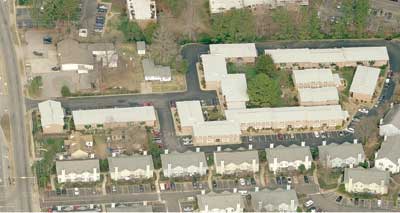 |
| (2) Aerial view of the Mayfair Mews Apartment Complex, pre-impact. (Photo from the City of Virginia Beach Pictometry, Electronic Field Study Software. Used with permission.) |
THE AIRCRAFT
The aircraft, an FA-18D Hornet, was 56 feet long, had a wingspan of 40 feet, and weighed approximately 37,000 pounds. No live ordnance was aboard. The jet was fully loaded with fuel. The aircraft was a two-seater and held a student pilot and an instructor pilot. Both pilots successfully ejected from the aircraft moments before impact; they suffered minor injuries (photos 3-4).
![(3) The aircraft canopy. [Photos by Robert Anderson, Virginia Beach (VA) Fire Department, unless otherwise noted.]](https://emberly.fireengineering.com/wp-content/uploads/2012/11/bara3-1211fe.jpg) |
| (3) The aircraft canopy. [Photos by Robert Anderson, Virginia Beach (VA) Fire Department, unless otherwise noted.] |
 |
| (4) The first pilot was located one block away from the crash scene. |
IMPACT
Impact scars and footage taken from a security camera indicate the jet first struck the parking lot directly in front of the apartment complex. After the initial impact, it bounced and slid through two attached apartment buildings, 1003 and 1005 Fleming Circle, before coming to rest in the courtyard area. The area involved measured approximately 650 feet by 300 feet. The buildings that the plane punched through were divided into eight apartments; two were not rented (photo 5). Of the remaining six apartments, no one was home in four of them. Occupants of the two remaining units escaped unhurt.
![(5) Entrance of Mayfair Mews Apartment Complex (side A) moments after impact. [Photo by Robert Oechsner, Virginia Beach (VA) Fire Department.]](https://emberly.fireengineering.com/wp-content/uploads/2012/11/bara5-1211fe.jpg) |
| (5) Entrance of Mayfair Mews Apartment Complex (side A) moments after impact. [Photo by Robert Oechsner, Virginia Beach (VA) Fire Department.] |
TACTICS AND STRATEGY Command/Operations
The initial command officer was in the area at the time of the crash. On witnessing a large column of smoke in the area, Car 8 proceeded to the incident. Battalion 1 (B-1), who also witnessed this large column of smoke, requested a second alarm moments after the dispatch. As Car 8 approached the scene, it was apparent that multiple buildings were on fire, and isolating an address was difficult. As he entered the apartment complex, he noticed multiple apartment buildings burning with heavy black smoke showing from behind the buildings. Car 8 and B-1 joined at the front of the apartment the jet had impacted and made their incident objectives known: search and rescue and fire containment/extinguishment. B-1 performed a walk-around, and Car 8 set up the command post on side A of the complex. From this vantage point, three apartment buildings were burning and the tail of the aircraft was visible through the hole in the burning building on side A. Car 8 announced Command with B-1 and requested a third-alarm assignment.
Engine 11 (E-11) and Ladder 11 (L-11) were the first suppression units to arrive, followed by E-8 and L-8 (a tower ladder). E-11 and L-8 set up on the A side. L-11 continued to the B side of the complex. E-11 secured a water source from the hydrant on Fleming in front of the impacted buildings. E-8 reverse-laid a supply line from L-8 to a hydrant on Birdneck Road (photo 6). B-1 directed water on the area impacted by the F-18 with two 2½-inch handlines and a truck-mounted deck gun flowing 600 gallons per minute (gpm). With the two 2½-inch lines and the deck gun in service, 1,000 gallons were immediately deployed from E-11. L-8 was set up and flowing two master streams, applying 2,500 gpm on the apartment and aircraft (photo 7). This immediately darkened down side A, allowing E-3’s crew to concentrate on search and rescue of the apartments immediately connected to the impact zone as well as those involved in and threatened by fire.
 |
| (6) Division A—Command, Engine 11, and Ladder 8. |
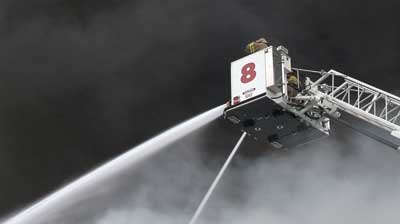 |
| (7) Ladder 8 flowing on Division A. |
Navy aircraft continued to fly, circling overhead at low altitudes, resulting in barely discernible communications. Command notified dispatch to request that Oceana cease air operations overhead and respond an aircraft rescue firefighting (ARFF) vehicle. As additional units arrived on scene, three divisions were established: Division A, the 24th Street Division, and Division D. (The specific functions of each division are discussed below.) The goal was to divide this incident into workable pieces and a manageable span of control. Each building or sets of buildings on fire became an independent division.
B-1 (with a field technician) was assigned to continue operations on side A as Division A. TAC-Channel 4 was to remain his TAC channel. Under his direction were E-11, E-17, and E-3; L-8; and the Navy ARFF vehicle. This division worked apartment buildings 1001, 1003, and 1005 Fleming Circle. The impact area was 1003 Fleming; 1005 and 1001 were exposed and on fire. Since 1007 Fleming was separated by a masonry fire wall, it did not receive any flame damage but sustained smoke and water damage. Shortly into the incident, B-1 was replaced by B-14 as Division A. B-1 then moved to Division D to assist B-7.
L-11 was positioned on side B of the complex. This area was heavily involved in fire because of the jet fuel saturating that area of the complex. Command directed B-4, the second-alarm battalion chief, and the entire second-alarm units to proceed to side B by way of 24th Street. This became the 24th Street Division. B-4 was ordered to attack, confine, stop the fire spread, and search the B side buildings.
B-4 and Car 7 became 24th Street Division, which used TAC-Channel 5. L-11 was supplied by E-21, L-16 was supplied by E-16, and L-21 was supplied by E-5. E-14’s crew staged on Birdneck Road near Maximus Square Apartments and walked to the scene. On arrival, they were directed to use handlines off E-16 to suppress fire and perform searches of the apartment. In all, the second-alarm units used three hydrants and supplied three aerial ladders. The engine companies performed searches as fire progressed rapidly to side C and unburned apartments. Units working the 24th Street Division were E-5, E-14, E-21, and E-16; L-11, L-16, and L-21; Navy E-31; and Fire Squad 10 (FS-10). In this Division, 1009, 1011, and 1013 Fleming Circle were either destroyed or heavily damaged by fire.
The fire progressed around the circular-style apartment complex. Side D was now on fire. Reviewing the prefire plan with B-1, Command determined Marabou Drive and Nighthawk Drive provided the best access to side D for incoming apparatus. E-12 arrived with the second alarm and positioned itself on Marabou. E-12’s crew extended a garden stretch through a fence separating Mayfair Mews from the condominiums on Marabou. Command assigned B-7 to side D with E-12 and named it Division D. B-7 was provided TAC-Channel 6.
E-3 supplied E-12 from a hydrant on Marabou and used the garden stretch to work the fire until additional units arrived. Additionally, E-8 and E-20, L-9 and L-1, and FS-3 were ultimately assigned to Division D. L-9 received a water supply from E-12 and flowed water from its aerial. In this Division, jet fuel had ignited a building with three townhomes (1023, 1021, and 1019 Fleming Circle) as well as a laundry building. This division provided search and suppression of these units. Also, 1025, 1027, and 1029 (also townhome-style apartments) were involved in fire. Damage to these units was limited because of aggressive handline deployment and attack.
Cars 1 and 2 and B-3 arrived. Car 2, the deputy chief of operations, assumed command, and Car 8 became Operations Section chief (photo 8). Command requested a fourth alarm. Ultimately, with the alarms requested and special-call units, this incident went to five alarms and 158 firefighters working from the VBFD and Navy Mid-Atlantic Fire Department. Mutual aid was requested from the surrounding cities of Norfolk, Portsmouth, and Chesapeake to provide backfills to the vacant stations within the city. Call-back personnel from off-duty shifts were used to staff reserve engines from the VBFD and were sent to backfill additional vacant fire stations. Additionally, numerous other VBFD personnel were called back and assigned to key tasks throughout the incident. Because of the extended operations of this incident, rehabilitation of the crews was required, as were food, water, portable toilets, and tents, which were procured by the Finance Section chief.
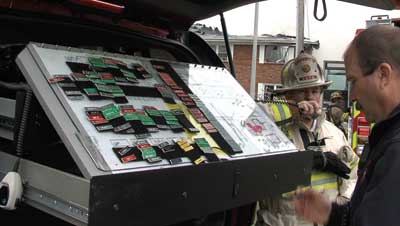 |
| (8) Operations section chief on side A. |
|
|
![Water flow at the peak of the incident was estimated to be 7,000 gpm. [Illustration by Deborah Gaudet, Virginia Beach (VA) Fire Department.]](https://emberly.fireengineering.com/wp-content/uploads/2012/11/baraf1-1211fe.jpg) |
| Water flow at the peak of the incident was estimated to be 7,000 gpm. [Illustration by Deborah Gaudet, Virginia Beach (VA) Fire Department.] |
Once the initial incident objectives of suppression and search and rescue were completed, hazardous materials [carbon fibers (see “Carbon Fiber-Reinforced Composite Materials” sidebar) and jet fuel] became the key concern. Operations assigned a hazmat group led by the Virginia Department of Emergency Management’s (VDEM) hazardous materials officer (HMO). This group, assigned TAC-Channel 4, performed research and gathered intelligence on the carbon fibers and jet fuel. Firefighters, police, and emergency medical services personnel, as well as the fire equipment, hose, nozzles, and apparatus, had to be decontaminated (photo 9).
 |
| (9) Decontamination. |
A Medical Group was assigned and operated on TAC-Channel 7. Its supervisor reported directly to Operations. The two pilots successfully ejected at low altitudes. They were found, treated, and transported to Sentara Virginia Beach General Hospital (SVBGH). Because of the nature of the incident, mass casualties and fatalities were anticipated. The Medical Group set up an elaborate triage area and coordinated with SVBGH for mass triage and decontamination of any inbound patients. There were no fatalities and no major casualties. Five patients were treated; they refused transportation. Anxiety and chest pains were the common complaints among the five patients.
As the incident continued to progress, Car 2 filled the rest of the Incident Command System (ICS) Section chief positions. He assigned B-13, Plans Section chief; B-9, Logistics Section chief; and Car 3, Finance Section chief. A liaison to the IC coordinated with the arriving representatives of the following agencies: Department of Defense, U.S. Navy, Environmental Protection Agency, VDEM, the medical examiner’s office, state police, the state health department, and the Navy on-site cleanup contractor (HEPCO).
The Virginia Beach police and EMS were brought into the command structure, and a unified command post was established about one hour after the jet crashed. The VBFD public information officer (PIO), B-12, coordinated public information. He worked with all the agencies’ PIOs to establish talking points and unified media releases. Additionally, as naval officials began to arrive, they offered any resources necessary to mitigate the situation.
The fire was under control within an hour of dispatch. Units completed primary and secondary searches within 11⁄2 hours of the crash in all buildings that did not collapse. Searches continued after nightfall in buildings that collapsed; fire extinguishment of hot spots continued into the next day. By 2300 hours, B-7 reported all searches were completed in the collapsed areas.
DIVISION A
Following is an account of the activities of Division A presented by Battalion Chief James Ramsey.
B-14 was assigned Division A per Operations, relieving B-1. Division A crews consisted of E-11, L-8, E-3, E-17, Navy Regional Crash Truck, and E-8 (driver only). Division A objectives included containing heavy fire in Units 1001, 1003, and 1005. This objective was met by master stream coverage from L-8 and E-11. The fire was contained to these units and did not spread to exposure units 1007 (side B) and 1035 (side D). Additionally, crews from E-3, E-11, and E-17 conducted primary/secondary searches on units 1001, 1005, and 1007 with an “all clear.”
Another objective was to place foam on the F-18 burning aircraft to suppress the fire and carbon fibers. Division A units temporarily shut down the master stream operation to give the Navy regional crash truck access to the aircraft (photo 10).
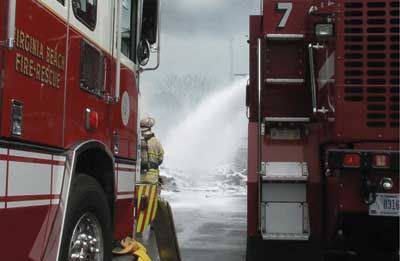 |
| (10) With a Virginia Beach engine as the water supply, a Navy ARFF applies foam to the tail section from the 24th Street Division. |
Additionally, personnel from E-3 and E-17 provided assistance to physically move a 16-foot loaded construction trailer to give the crash truck the most advantageous position between units 1007 and 1009. Division A was transferred from B-14 to B-4 with a pass down that unit 1003 could not be searched because of structure instability. B-14 then assumed the role of fire marshal.
24th STREET DIVISION
Following is an account of the activities of the 24th Street Division presented by District Chief David Hutcheson.
Arriving shortly after Car 8 and B-1, Car 7 went to the 24th Street Division and became the 24th Street Division supervisor. When Car 7 arrived, L-11 was already in position and was setting up for a defensive attack. Heavy volumes of smoke and fire were showing from the apartments with exposures on both sides. Car 7 led the division at L-11 (photo 11). Water for L-11 was supplied by E-21 on 24th Street, several hundred feet away. The five-inch supply line had to be hand carried through a field, and a chain-link fence had to be cut away to reach L-11. L-11 flowed extensively in unit 1011, which had heavy fire on the first and second floors as well as in the attic. L-11 was used to darken down fire in unit 1009 as well. On the arrival of E-16 and L-16, they were ordered to position on 24th Street behind the complex. E-16 supplied L-16 for defensive operations in building 1011. L-16, a platform, used chainsaws to cut tree branches to get through the tree canopy to flow water off of 24th Street. E-16 had multiple handlines in operation at different times during the operation in 1009, 1011, and 1013. L-21, supplied by E-5, was positioned on side C of the complex on Tenbee Lane. These units were staged in case additional master streams were needed.
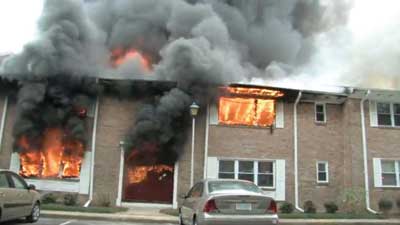 |
| (11) The 24th Street Division. (Photo by Martin Grube.) |
While offensive operations in buildings 1009 and 1013 were occurring, defensive operations were simultaneously being conducted in 1011. L-11’s crew searched building 1009, and E-14’s crew searched building 1013. No victims were found. FS-10 and E-21 crews assisted with search, fire containment, and ventilation in all three structures.
B-4 assisted Car 7 with coordinating E-21’s supplying of L-11 and E-16’s and L-16’s efforts. B-4 coordinated many other activities until reassigned to Division A.
DIVISION D
Following is an account of the activities of Division D presented by Battalion Chief Dennis Keane.
On arrival, B-7 reported to the command post and was assigned by the IC Car 8 to oversee the firefighting operation on Division D and to maintain radio communications on TAC-Channel 6.
Reporting to Division D, B-7’s size-up found one two-story apartment building with apartments 1019, 1021, and 1023 well involved in fire. Floors 1 and 2 of each apartment had fire showing through most of the windows at the rear of the structure. Heavy black smoke was showing from the attic area, indicating the fire was now also taking hold of the common attic. Two similar style apartment buildings in close proximity of the burning apartments were now threatened exposures. Radiated and convected heat was traveling the short distance to the exposures, which was evident in some melted siding and distorted windows. The main objective for Division D was to protect the threatened exposures (photo 12).
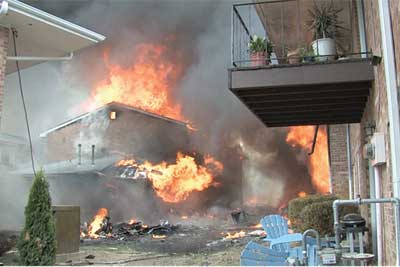 |
| (12) Division D. (Photo by Martin Grube.) |
Initial companies assigned to Division D were E-12 and E-8. E-12 was on a hydrant in an apartment complex one block over. E-8’s crew walked to Division D, as its engine was supplying water to Division A. Crews from E-8 and E-12 were in the process of completing a long gated wye handline stretch that included breaching a fence to reach Division D. Once the handlines were in place, crews were able to direct water between the burning apartment building onto the exposures. FS-3, E-20, and L-1 were added to Division D. Crews were rotated in and out based on their air consumption and the amount of work they were performing using the two handlines.
Primary searches in apartments 1019, 1021, and 1023 were hampered by the partial collapse of the common roof. In some apartments, the second floor had collapsed partially onto the first floor. Companies performed primary/secondary searches and checked for fire extension into the exposure buildings; apartments 1029, 1027, 1025, and 1015 and were all clear.
L-9 was assigned to Division D and was able to maneuver its apparatus to the Division D location. E-12 hand-jacked a five-inch supply line to the breach in the fence, and L-9 split-laid from the fence to its position on Division D. With L-9 in position, an elevated stream was able to be placed in operation to safely extinguish the remaining areas of fire in the fire building. The fire was placed under control in Division D shortly after L-9 began its operation.
Division D was successful in holding the fire to the apartments that were well involved on arrival. Primary and secondary searches were completed in units 1029, 1027, 1025, and 1015. Companies assigned to operate in this first phase were E-12, E-8, and E-20; L-1, L-9; and FS-3.
Later in the evening, FS-10 and E-11 were assigned to Division D to conduct a thorough secondary search of the fire units (1019, 1021, and 1023). This process involved removing a tremendous amount of burned debris resulting from the partial collapses.
FIRE MARSHAL’S OFFICE
This account is presented by Battalion Chief James Ramsey.
B-14 gained control of the investigation in reference to the structures; occupants’ accountability; and the coordination of various agencies to include EMS transport, the medical examiner, and the police department in case of fire fatalities. Four teams consisting of fire investigators, police detectives, and forensics personnel were established to assist with documenting the scene, collecting witness statements, obtaining video, and determining occupant accountability. These items were recorded and shared with DoD for its investigation. The VBFD Fire Marshal’s Office placarded and coordinated the demolition permit process for HEPCO to clear the condemned structures. This coordination included meeting with representatives from Virginia Natural Gas, Dominion Power, the Department of Environmental Quality, and Virginia Beach building and housing code officials.
PUBLIC INFORMATION OFFICER
This section is presented by Battalion Chief Timothy Riley.
B-12 served as the VBFD’s PIO. During the event, the PIO logged more than 70 hours. This event had global media coverage. He spoke with all national media affiliates, BBC, Beijing, Canada, and CNN international media outlets. He facilitated with the IC and with the Navy’s public affairs and command staff officers. He attended the two daily briefings at the crash site and assisted with family support during the crash aftermath.
The PIO established a media staging area at 24th Street and Birdneck Road and notified all local media outlets of the staging area location. This kept all media confined to one area and made it much easier to manage. The location was close enough to the site to satisfy the media interest. The VBFD PIO then facilitated with the Navy’s command staff and the Navy’s public affairs officers to create incident talking points through joint messages. Additionally, he provided the media with accurate, timely, and regular news updates. Press releases were coordinated with the Navy and city officials, Fleet Forces command, the mayor, the fire and police chief, and the Oceana Base commander. The PIO provided the Emergency Operations Center (EOC) with updates, attended the family briefing, updated apartment occupants, and provided media updates on the city’s family liaison plan and progress—i.e., assisting families in locating medications and personal items and reuniting pets with their owners.
AFTERMATH
VBFD personnel remained on scene for eight days. In the hours following the fire’s having been declared extinguished, the job was not complete. Any remaining airborne carbon fiber was of immediate concern. The industry standard for containing carbon fibers is to spray bowling alley wax to seal the fibers (photo 13.) This would allow workers to clean and remediate the debris field. Family assistance continued throughout the next eight days.
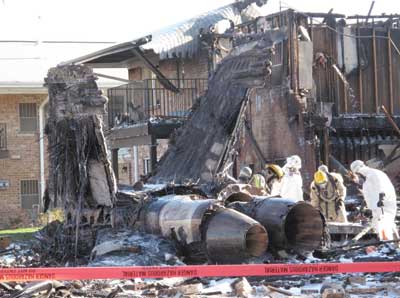 |
| (13) Applying bowling alley wax on the carbon fibers. (Photo by Michael J. Barakey.) |
All families were assigned a VBFD firefighter and a Navy chaplain. In addition to providing human comfort, personnel located eight pets and reunited them with their families; located and returned medications, wallets, identifications, and various other personal items; and honored special requests for heirlooms or other treasured items. When located, the objects were returned to their relieved owners (photo 14).
![(14) Residents were assigned a firefighter to assist with retrieving personal items. [Photo by Tim Riley, Virginia Beach (VA) Fire Department.]](https://emberly.fireengineering.com/wp-content/uploads/2012/11/bara14-1211fe.jpg) |
| (14) Residents were assigned a firefighter to assist with retrieving personal items. [Photo by Tim Riley, Virginia Beach (VA) Fire Department.] |
As the cleanup continued, the Environmental Protection Agency (EPA) monitored the air quality and noted no hazards. Storm drains were inspected with cameras. Soil testing was performed, and contaminated soil was removed and replaced with new soil. Residences that were not demolished were dusted and HEPA vacuumed; additionally, those apartments were swab tested. Refrigerators were emptied, and HVAC systems were tested for particulates and cleaned.
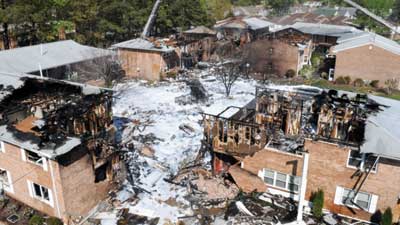 |
| (15) Aerial view of damage to the apartment complex. |
Thirty-four days later, occupants were allowed to return to Mayfair Mews. In this 34-day period, 920 tons of construction debris were removed; 659 tons of concrete were recycled; 1,090 tons of contaminated soil were removed; and the EPA ruled the area contaminate free. Utilities were restored; only two residents did not want to return to the complex.
SUCCESSES
Cooperative training had been ongoing between the Department of the Navy and the VBFD in anticipation of potential scenarios of this nature. At two training sessions (April 2010 and December 2011), the two agencies participated in off-site performance-based training using the Department of the Navy’s jet simulator (photo 16). This training focused on the inherent dangers of fighting a jet fire and allowed firefighters to practice suppression activities in a controlled environment. A third training session was conducted in February 2012 for all fire department personnel. Three-hundred and ninety-six VBFD personnel were trained by the Navy Mid-Atlantic Fire Department on jet aircraft fires. The danger of carbon fiber exposure was just one of the many topics covered.
![(16) VBFD firefighters performing suppression activities on a gas-fueled jet simulator in December 2011. [Photo by Kirk Kellerhals, Virginia Beach (VA) Fire Department.]](https://emberly.fireengineering.com/wp-content/uploads/2012/11/bara16-1211fe.jpg) |
| (16) VBFD firefighters performing suppression activities on a gas-fueled jet simulator in December 2011. [Photo by Kirk Kellerhals, Virginia Beach (VA) Fire Department.] |
Several other factors contributed to the positive outcome of this incident, including the following:
- Extensive training in command management and suppression activities.
- Early establishment of section chiefs, divisions, and groups.
- Level-headed decision making by company officers to overcome obstacles.
- Early unified command.
- Rapid arrival of resources.
- Effective, efficient communications of direction and orders.
- Exemplary radio discipline by fire department personnel.
- Identifying, building, and maintaining community relationships.
LESSONS LEARNED
The City of Virginia Beach and the VBFD learned from this incident. As the after-action reports are completed and government reviews the successes, it is important to learn for the future. This was a large-scale event that encompassed many city, state, federal, and military agencies; it is imperative that the lessons are shared.
- The VBFD found that training with the Navy and the resulting cooperation were key to success in this incident. Always train and take the opportunity to share information regarding potential events in your community.
- Be familiar with the ICS, and be able to expand it with ease should an incident warrant it. This takes training and experience. Use prestaged events in your community like holiday parades, festivals, and natural disasters to implement an expanded ICS.
- Have a unified command, and be inclusive. Include other public safety partners in the command post, and establish a liaison who reports directly to the command post to capture the responsible parties or representatives of the many impacted agencies and jurisdictions that will flood the event. Maintain a list of contacts with the liaison. Even if that responsible person is not relevant now, he may be important in the future.
- Establish and use defined operational periods. During the planning process, hold meetings while identifying incident objectives and resource needs for the next operational period.
- Remember that you are not alone in a large-scale event. City government and public safety must work together not only to mitigate the incident but also to restore normalcy to the community in a timely and safe manner.
MICHAEL J. BARAKEY is a district chief with the Virginia Beach (VA) Fire Department, where he is assigned to operations. Previously, he was chief of training. He is a hazmat specialist, an instructor III, a nationally registered paramedic, and a neonatal/pediatric critical care paramedic for the Children’s Hospital of the King’s Daughters in Norfolk, Virginia. Barakey is a plans team manager for the VA-TF2 US&R team and has a master of public administration from Old Dominion University in Norfolk, Virginia. He is a classroom instructor at FDIC.
DEBORAH L. GAUDET, a 17-year veteran of the fire service, is a captain with the Virginia Beach (VA) Fire Department, where she is assigned as a shift safety officer. She is a Pro-Board health and safety officer and an incident safety officer. In this capacity, she has served as an instructor for FDSOA at the FDIC Mid-Atlantic Symposium. She is a past plans officer for the VA-TF2 US&R team and a National Fire Protection Association appointee on the Technical Committee on Respiratory Protection Equipment. She has a BS in safety and health.

